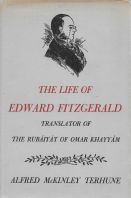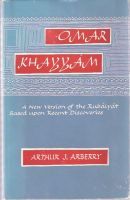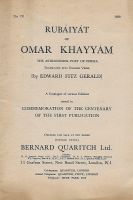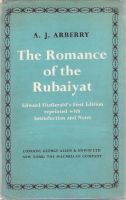A bibliography of the Rubáiyát of Omar Khayyám together with kindred matter in prose and verse pertaining thereto. Collected and arranged by Ambrose George Potter. London, Ingpen and Grant, 1929. xiii. 313 p.
Reprinted 1994 by Olms, Hildesheim.
Archives
The nectar of grace. ‘Omar Khayyám’s life and works
The nectar of grace. ‘Omar Khayyám’s life and works by Swámí Govinda Tírtha (V.M. Datar). With foreword by Sir Akbar. Allahabad, Kitabistan, 1941.
Includes the Persian text of the Ruba’iyat with an English translation. Reissued in 2010 by Oxford City Press.
Contents:
Bibliography
History and notices regarding ‘Omar Khayyam
‘Omar Khayyam’s scientific and philosophic works
Manuscripts and editons of ‘Omar Khayyam’s Quatrains
Works of other Persian authors.
The life of Edward FitzGerald translator of The Rubáiyát of Omar Khayyám
The life of Edward FitzGerald translator of The Rubáiyát of Omar Khayyám. Alfred McKinley Terhune. New Haven, Yale University Press; London, G. Cumberlege, Oxford University Press, 1947. xi, 373 p.
Into an old room; a memoir of Edward FitzGerald
Into an old room; a memoir of Edward FitzGerald. Peter De Polnay. New York, Creative Age Press. [1949]. VIII, 344 p.
Contents:
Background and beginning
Bury, Cambridge & Thackeray
Boulge and Browne
Marriage
The Rubáiyát and the Letters
Posh and old age
Appendix
Bibliography
Omar Khayyám. A new version based upon recent discoveries
Omar Khayyám. A new version based upon recent discoveries by Arthur J. Arberry. New Haven, Yale University Press, 1952.
Contents:
Introduction (p. 7)
Translation (p. 49)
Notes (p. 135)
Parallels from FitzGerald (p. 143)
Table of manuscripts and editions (p. 151)
A catalogue of various editions of the Rubáiyát of Omar Khayyám …
A catalogue of various editions of the Rubáiyát of Omar Khayyám, translated by Edward FitzGerald. In commemoration of the first publication, together with other works by or about Edward FitzGerald. With a foreword by A.J. Arberry. London, Quaritch, 1959.
Lists 126 numbers.
The Romance of the Rubáiyát: Edward FitzGerald’s First Edition
The Romance of the Rubáiyát: Edward FitzGerald’s First Edition. A.J. Arberry. London, Allen & Unwin, 1959. 244 p. Reissued in 2016.
Summary:
In this scholarly centennial edition, Arberry makes use of FitzGerald’s own notes, letters, and Latin version of the quatrains to show how the English poem emerged out of the Persian sources.





